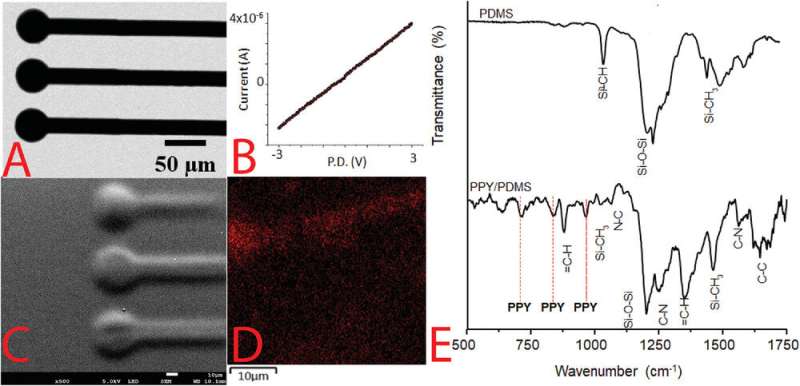This article has been reviewed according to Science X's editorial process and policies. Editors have highlighted the following attributes while ensuring the content's credibility:
fact-checked
peer-reviewed publication
trusted source
proofread
New research takes step towards laser printed medical electronics

Researchers have taken a major step towards 3D laser-printed materials that could be used in surgical procedures to implant or repair medical devices.
A team of scientists, led by researchers at Lancaster University, has developed a method to 3D-print flexible electronics using the conducting polymer polypyrrole, and they have shown that it is possible to directly print these electrical structures on or in living organisms (roundworms).
Their findings are reported in the paper Creating 3D objects with integrated electronics via multiphoton fabrication in vitro and in vivo, which is published in Advanced Material Technologies.
Although at a proof-of-concept stage, researchers believe this type of process, when fully developed, has the potential to print patient-specific implants for a variety of applications, including real-time health monitoring and medical interventions, such as treating epilepsy or pain.
Dr. John Hardy, Senior Lecturer in Materials Chemistry at Lancaster University and one of the lead authors of the study, said, "This approach potentially transforms the manufacture of complex 3D electronics for technical and medical applications—including structures for communication, displays, and sensors, for example. Such approaches could revolutionize the way we implant but also repair medical devices. For example, one day technologies like this could be used to fix broken implanted electronics through a process similar to laser dental/eye surgery. Once fully mature, such technology could transform a currently major operation into a much simpler, faster, safer and cheaper procedure."
In a two-stage study, the researchers used a Nanoscribe (a high-resolution laser 3D printer) to 3D-print an electrical circuit directly within a silicone matrix (using an additive process). They demonstrated that these electronics can stimulate mouse neurones in vitro (similar to how neural electrodes are used for deep brain stimulation in vivo).

Dr. Damian Cummings, Lecturer in Neuroscience at University College London, a co-author of the study who lead the brain stimulation work, said, "We took 3D printed electrodes and placed them on a slice of mouse brain tissue that we kept alive in vitro. Using this approach, we could evoke neuronal responses that were similar to those seen in vivo. Readily customized implants for a wide range of tissues offers both therapeutic potential and can be utilized in many research fields."
In the second stage of the study, the researchers 3D-printed conducting structures directly in nematode worms, demonstrating that the full process (ink formulations, laser exposure and printing) is compatible with living organisms.
Dr. Alexandre Benedetto, Senior Lecturer in Biomedicine at Lancaster University, and another lead author of the study, said, "We essentially tattooed conductive patches on tiny worms using smart ink and lasers instead of needles. It showed us that such technology can achieve the resolution, safety and comfort levels required for medical applications. Although improvement in infrared laser technology, smart ink formulation and delivery will be critical to translating such approaches to the clinic, it paves the way for very exciting biomedical innovations."
The researchers believe these results are an important step highlighting the potential for additive manufacturing approaches to produce next-generation advanced material technologies—in particular, integrated electronics for technical and bespoke medical applications.
The next steps in the development in research are already underway exploring the materials in which it is possible to print, the types of structures it is possible to print and developing prototypes to showcase to potential end users who may be interested in co-development of the technology. The researchers believe the technology is around 10 to 15 years from being fully developed.
More information: Sara J. Baldock et al, Creating 3D Objects with Integrated Electronics via Multiphoton Fabrication In Vitro and In Vivo, Advanced Materials Technologies (2023). DOI: 10.1002/admt.202201274
Journal information: Advanced Materials Technologies
Provided by Lancaster University





















